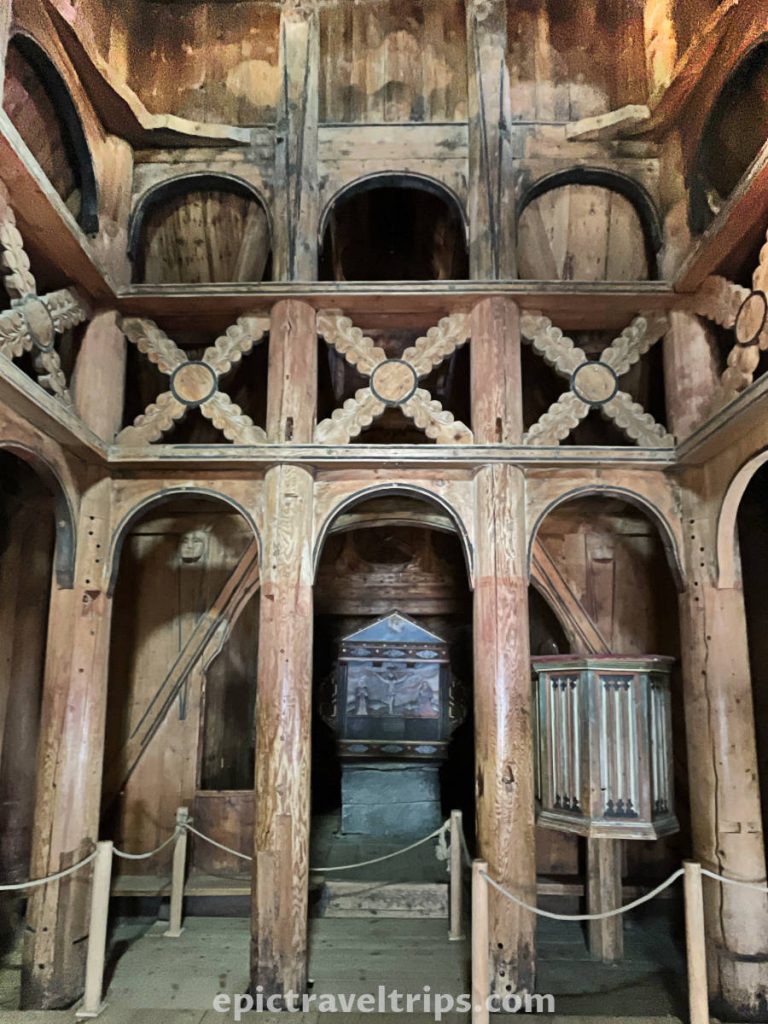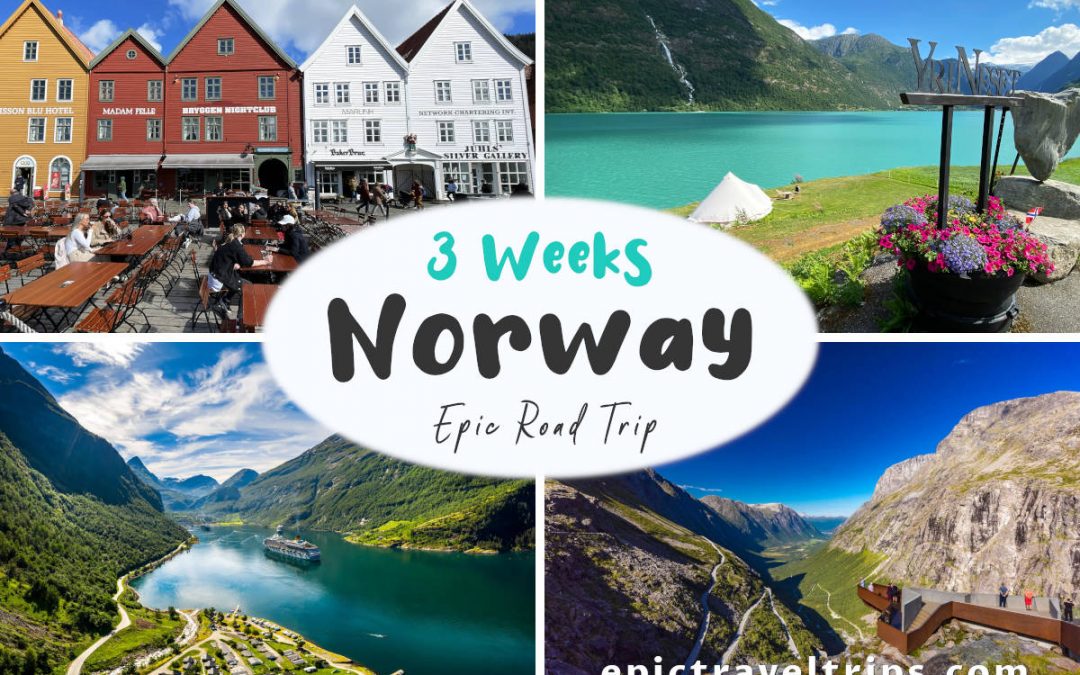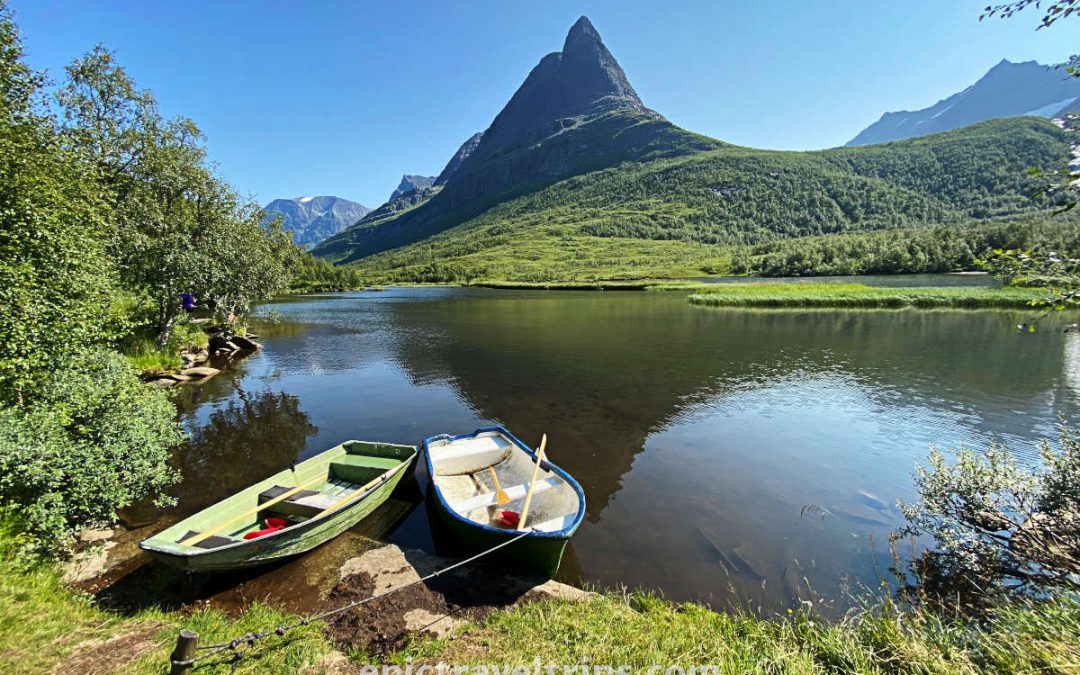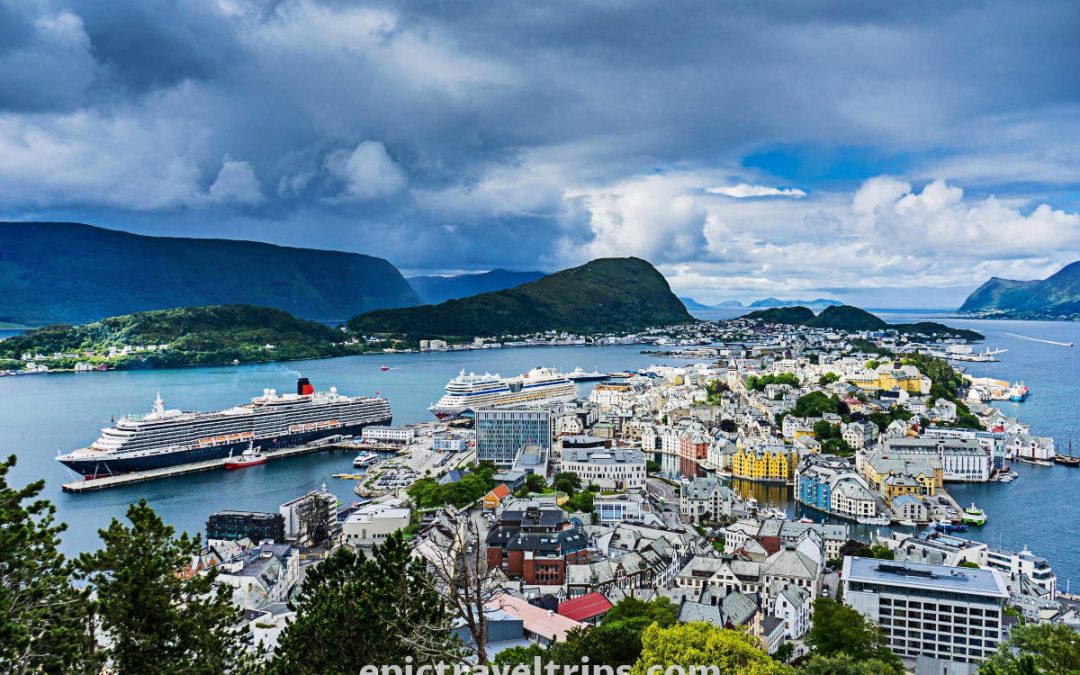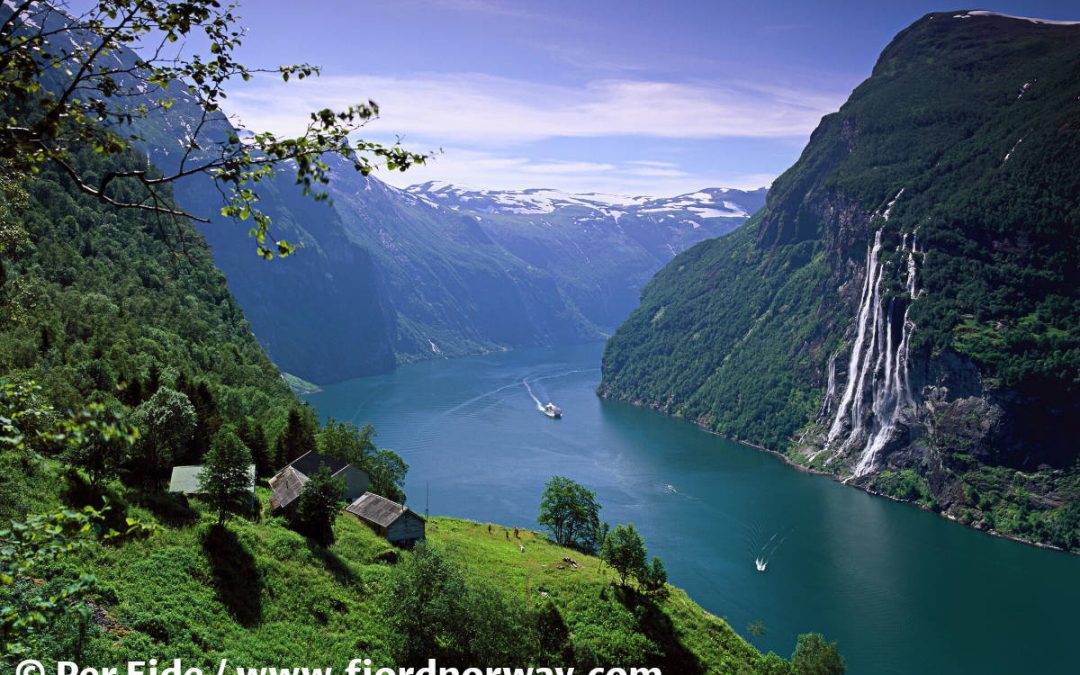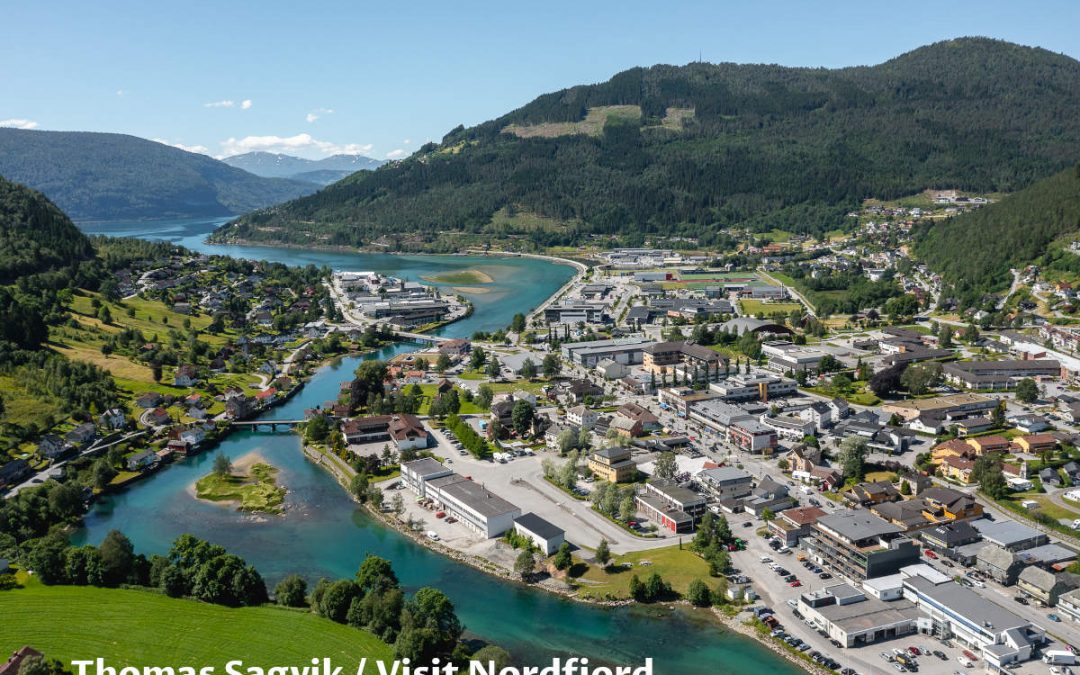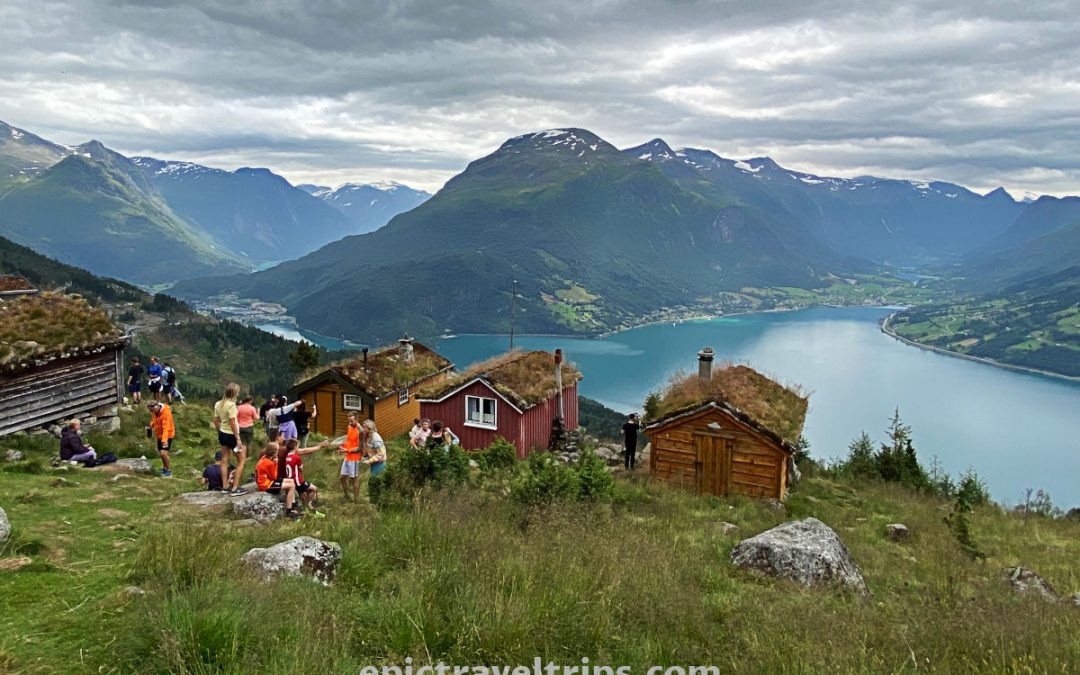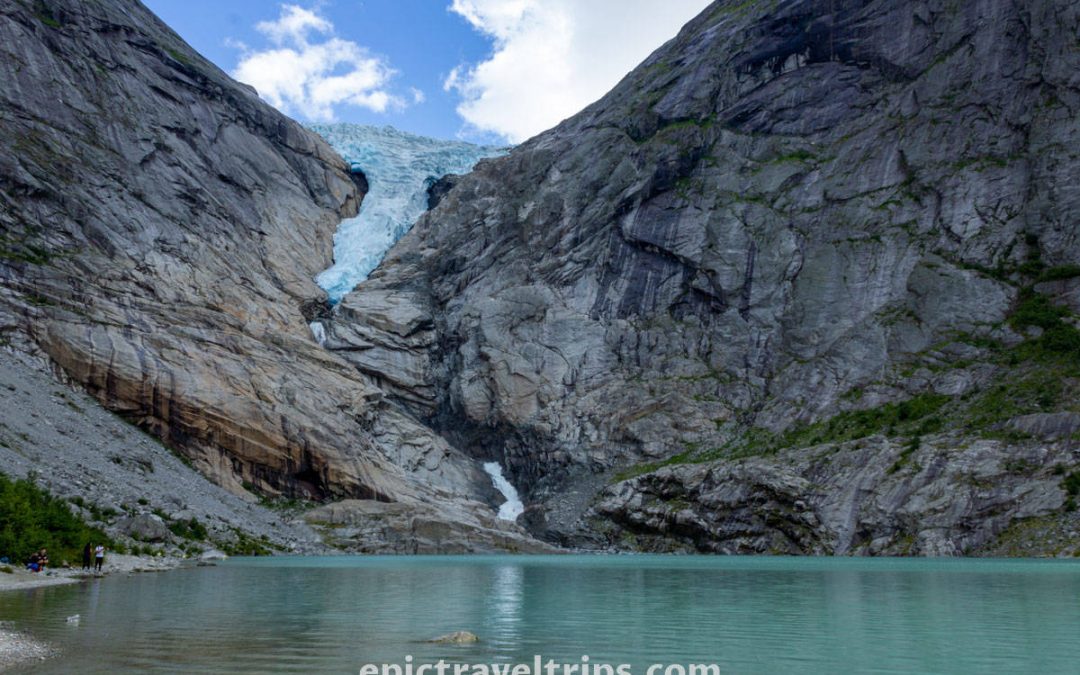- What is Stave Church?
- Similarities With Viking Ships
- Short History Context
- Where is Borgund located?
- How To Reach Borgund?
- Where To Park?
- How Long Does The Visit Take?
- How Much Is The Entrance Fee?
- Opening Hours & Season
- When Is The Best Time To Visit?
- What Is Nearby Borgund?
- Borgund – Our Impressions
A Stave Church Described
Borgund stave church is a medieval black wooden one and represents the early Christianity period in Norway.
The constructors built the church in the year 1183. However, the limberjacks cut the logs in the winter of 1180.
The period between 1130-1350 was the golden age for the construction of stave churches. After 1349, when the plague (the black death) struck Norway as most of western Eurasia, constructions of stave churches were seldom.
The constructors built more than one thousand stave churches. Today only 28 “survived” the test of time. Borgund is the best preserved of all without being too “modernized” by the restorations. It is as original as it gets.
Norwegian stave churches are a unique heritage to the world’s culture. Although, similar church constructions existed in other European countries.
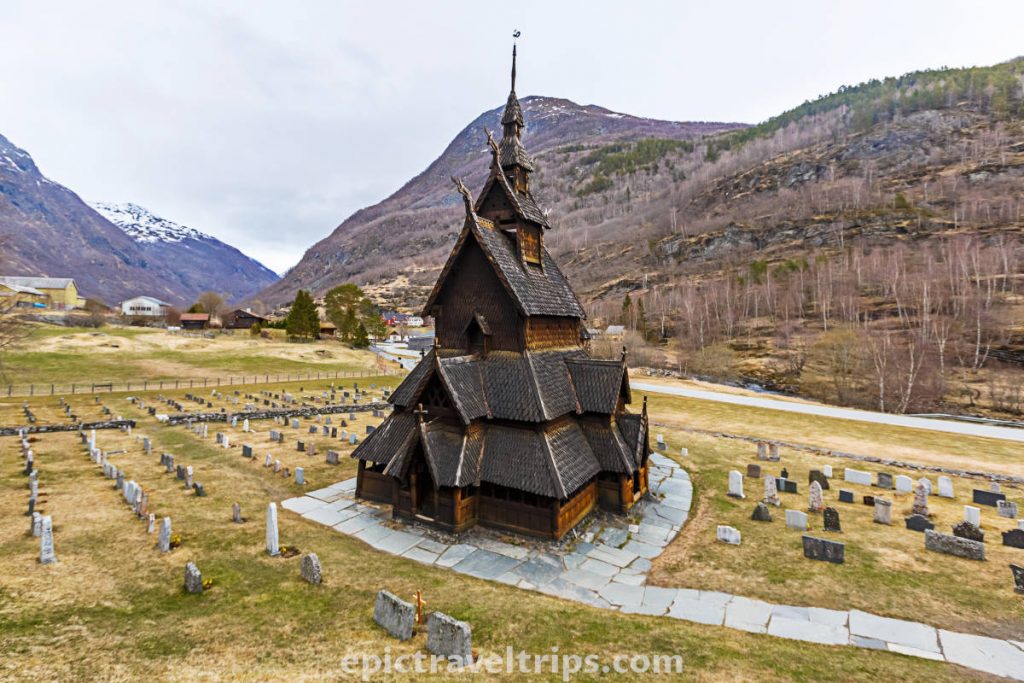
Visit To Borgund Stave Church
After parking our car, we entered the Visitors Center of Borgund Stave Church, which is not just a ticket office but a souvenir shop, exhibitions, and events hall. From there, we crossed the road and passed by the stone wall approaching both new and old (black) Borgund churches.
Exterior
From the outside is an old cemetery around Borgund Stave Church bordered by a stone wall. Next is the “new” Borgund church on the stone fundamentals and black stave bell tower in between the two.
My first impression was the complexity of construction. The builders used so many black wood pieces designed to the details.
The striking elements are the four carved dragon heads on the rooftops and the shingled roofs and walls. However, the strongest impression is the smell of the material (black tar) used to preserve the wooden parts from deteriorating.
In front of the church entrance was a lady (curator) who gave us a brief introduction to the church. She was open to questions that we asked later.

Interior
Packed with new pieces of information, we entered the church. The interior of the church has twelve columns. Each column supports the nave’s elevated central space. Carved arches connect the columns. Above the arches, cross-shaped carved diagonal trusses support the upper columns (roof beams). Along the wall inside the church is a row of benches.
Inside the church are three main spaces. The most spacious interior space of the church is a raised central nave.
Chancel is the second and has a stone altar and an altarpiece above it. The painting on the altarpiece shows the crucifixion in the middle. On the sides is the Virgin Mary on the left and John the Baptist on the right.
At the back is the third space called the apse, the semicircular recess covered with a hemispherical vault that we can see from outside while approaching the church.

An additional ambulatory porch runs around the church to preserve it from harsh Norwegian weather conditions. That is the black exterior we see from the outside.
To describe it in simple words, imagine the old man dressed in a black coat. It is a church on the inside, covered with black wooden shingles on the outside. After all, the church is an “oldy” and should be well tucked away and sheltered from the weather conditions. In addition, it needs to last a very long time.
Similarities With Viking Ships
While at the site, we asked the guide (curator) about similarities between Viking ships and stave churches. We were interested in the carved dragon’s heads on the rooftops (found on the prows of the Viking ships), roof tiles reminiscent of fish scales, and roof shape as upside down turned Viking ship hull.
Roof Shape As Upside Down Turned Viking Ship Hull
Look at the roofs of a stave church. Aren’t they like Viking ship hulls or what? Is this similarity a myth or…
It is a myth and has nothing to do with the two. However, there is one thing to bear in mind that we will discover for you in a minute (notice italic font below).

We have a photo of a Viking ship from Sagastad Viking Center so you can decide for yourselves.
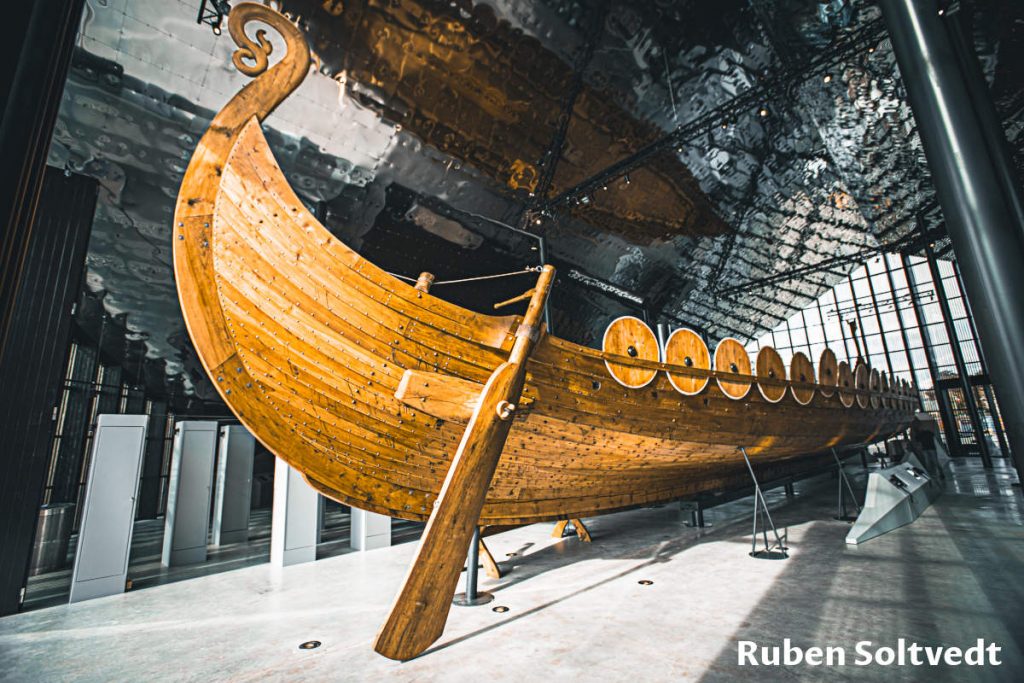
Roof Tiles and Outside Walls Are Reminiscent Of Fish Scales
Look at the roof tiles and outside walls. Especially how they are packed one to another. Aren’t they like fish scales patterns?
Well, that is another myth.

Dragon’s Heads On The Rooftops
Finally, it is a truth and not a myth… Viking ships’ prows design inspired the churches’ craftsmen.

Look at the one sample of a Viking ship prow.

According to the curator, only dragons are an artifact of the Vikings’ Age. The others are just a myth. Although, she mentioned that most craftsmen knew how to build Viking ships prior to they started building the churches.
Recent research showed that Viking shipbuilders and stave church constructors used similar building techniques. One example is the nails needed to assemble the wooden shingles. More precisely, the use of an additional wedge as a part of a two-part nail system.
The stave church constructors used “arched knees” as reinforcing structural elements. The Viking shipbuilders used them as fastening elements.
Short History Context
In order to get the historical perspective together with stave churches, it is important to mention a few historical periods in Norway.
793 – 1066 Vikings age
Period with Scandinavian mythology consisted of tales about various deities, beings, and heroes. Religion was multi gods, belonged to North Germanic people, and mentions numerous gods such as Thor, Odin, Freyja, etc.
1030 – 1537 Medieval Catholic Christianity age
- The year 1030 – the Battle at Stiklestad. (The first traces of early Christianity in Norway).
- The year 1152 – Norway’s independent church province
- The year 1180 – Borgund stave church constructions
- The year 1349 – The plague struck Norway. (End of stave churches construction era).
The year 1537 and onwards – Lutheranism age
- The year 1537 – Lutheranism reformation and Real union with Danmark
- In the year 1868 – Borgund Stave Church replaced by the “new” Borgund Church
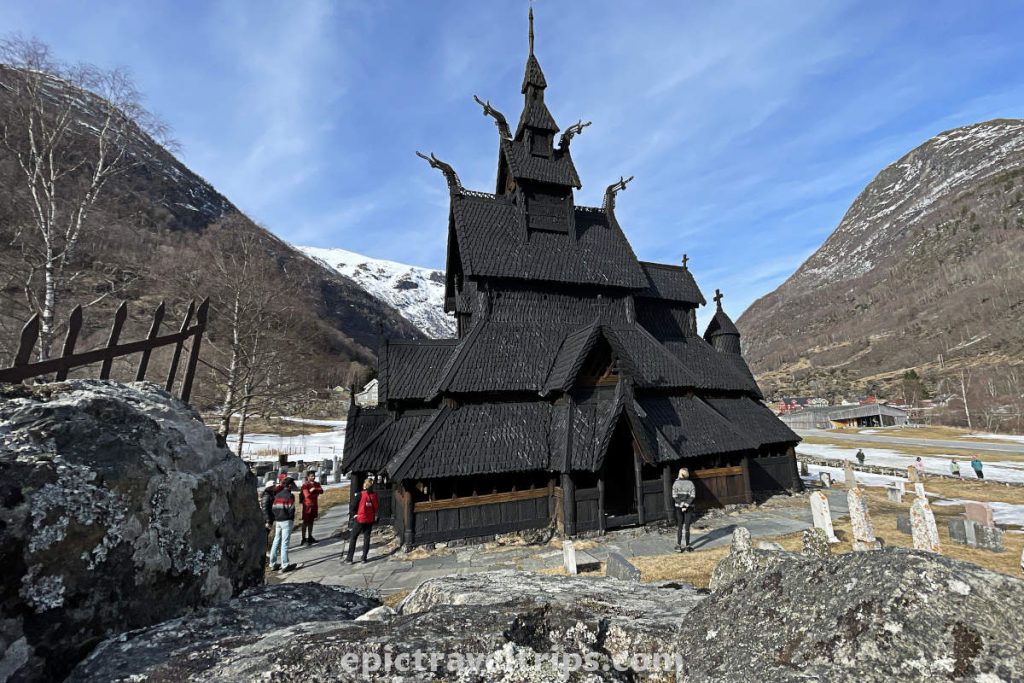
Where Is Borgund Stave Church Located?
Borgund Stave Church’s location is in the Vestland county of the Western Norway region in the proximity of the Lærdalsøyri administrative center.
Here are a few distance, time, and roads practical info:
- Oslo: 300 km (186,4 miles) south of the church, 4 hours 30 minutes drive, Road (E16)
- Bergen: 220 km (136,7 miles) west of Borgung, 3 hours 30 minutes drive, Road (E16)
- Flåm: 55 km (34 miles) west of the church, 55 minutes drive, Road (E16) – drive through 24,5 km (15 miles) long Laerdal Tunnel.
- Lærdalsøyri: 27 km (17 miles) north of the church, 30 minutes drive, Road (E16)
Lærdalsøyri was our base for exploring this area on our 3 Weeks Norway Epic Road Trip. We stayed at the budget hotel Lærdal Ferie- og Fritidspark. We further controlled our budget by resupplying in the local grocery shops and making our own food in the common kitchen.
If you click this link and make a purchase, we earn a commission at no additional cost to you.
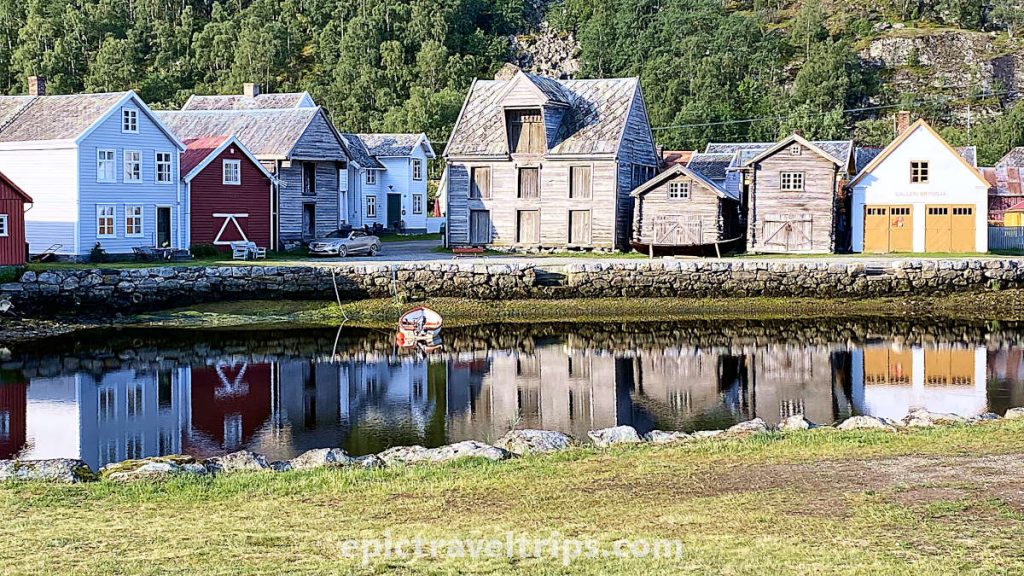
How To Reach The Borgund Stave Church?
There are limited options to reach Borgund. The car is the most convenient mean of transportation.
By Car: If you drive from Oslo, exit from the E16 highway before Borgundstunnelen. Drive the road Fv630 for about two minutes (1.6 km, 1 mile). Parking is at the Visitors Center of Borgund Stave Church on the left-hand side.
If your drive from Bergen, Voss, and Flåm direction, exit from the E16 highway after Borgundstunnelen. Drive the road Fv630 for about two minutes (1.6 km, 1 mile).
By Bus: There is a bus line 103 from the Lærdalsøyri bus terminal (near the Kiwi grocery shop), and it takes 45 minutes to reach Borgund Church.
By Train: Borgund is not on the national railway network. The closest railway station is at Flåm. From there probably need to switch to the bus to Lærdalsøyri using the Vy Bus operator. Finally, take the local bus line 103.

By airplane: The nearest airport is Sogndal Airport, a one-hour 15-minute drive by car from Borgund. Widerøe operates several daily flights to both Oslo and Bergen.
If you click this link and make a purchase, we earn a commission at no additional cost to you.
Where To Park For Borgund Stave Church Visit?
Parking is in front of the Visitors Center of Borgund Stave Church on the left-hand side. Borgund church is just on the other side of the road from the parking lot. There is separate parking for buses and camper vans also on the left-hand side just 50 meters prior to the Visitors Center parking.

How Long Time Did The Visit To Borgund Stave Church Last?
One hour is more than enough to visit the church, take photos, and hear the curator’s story about Borgund Stave Church.
Heaven is under our feet as well as over our heads. – Henry David Thoreau
We like to recommend to you a combined visit to the church and the Vindhellavegen hike. If you do both, then the time spent increases to several hours. We believe four hours are more than enough to visit Borgund Stave Church, hike to Vindhellavegen, and return.
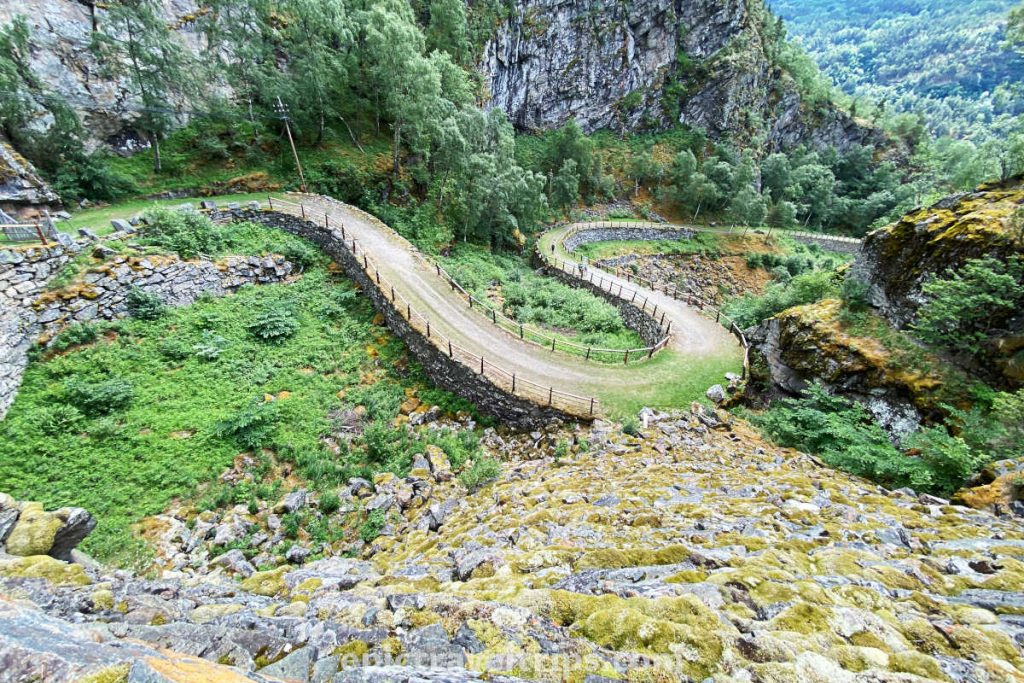
How Much Is The Entrance To Borgund Stave Church?
The entrance fee is not too expensive, considering that this is in Norway. You can buy tickets at the Visitors Center just across the street from the church.
*Please take this price list as an estimate
Opening Hours & Season
- Season: from mid-April to mid-October
- Opening hours: 09:30 – 17:30 every day
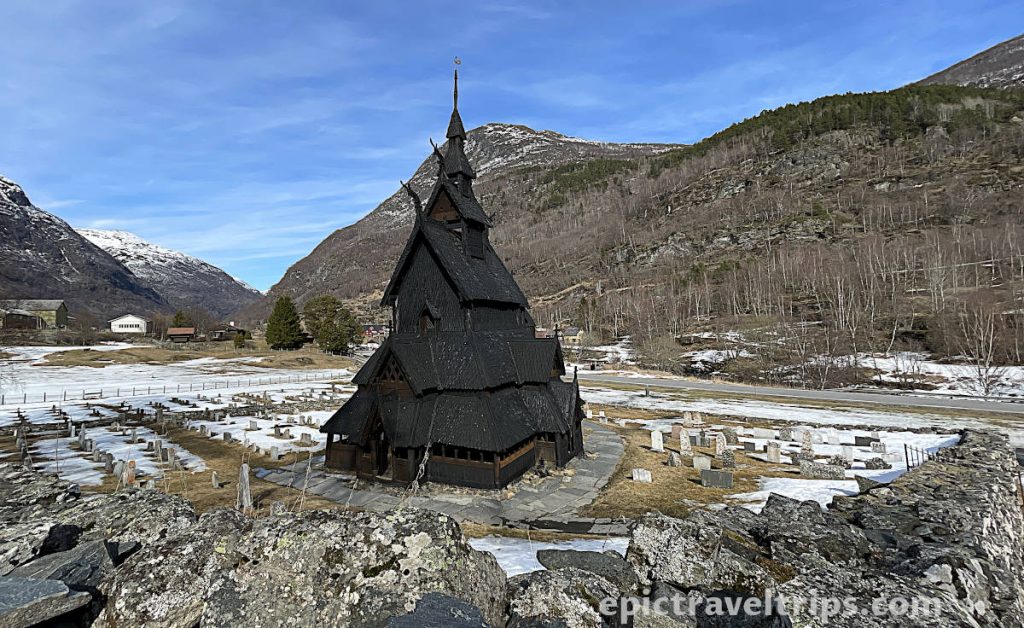
When Is The Best Time To Visit The Borgund Stave Church?
We visited Borgund Stave Church on several occasions and in different seasons. Both at the beginning of the season (end of April) and during the high season (mid-summer in July and August).
The most important is to have nice weather which is a challenge in Norway. We know that very well since we live in Norway since 2008.
The best chance to have really nice weather and have a pleasant visit to the church is in mid-July.

What Is Nearby Borgund Stave Church?
There are many amazing locations in the vicinity of the Borgund. We like to share with you some of the ones we have visited. Here are short descriptions and for more in-depth info, please click on the provided links.
All of these suggestions were part of our 3-Week Norway Epic Road Trip.

Vindhellavegen – The Old King’s Road
The closest attraction is, of course, Vindhellavegen. It would be a pity not to take this short and thrilling hike while being already at Borgund.
So probably the best suggestion is to combine a visit to the church with the Vindhellavegen hike as a short trip.

Lærdal Tunnel (Lærdalstunnelen)
On the way to Flåm, it is a 24 km (15 miles) long Lærdal Tunnel. We believe it was, at one point, the longest tunnel in the world, but we are not quite sure. However, to make driving through the Laerdal tunnel less boring, in several places, caves with blue lights on the walls and yellow ones on the edges were built to give the impression of the rising sun.
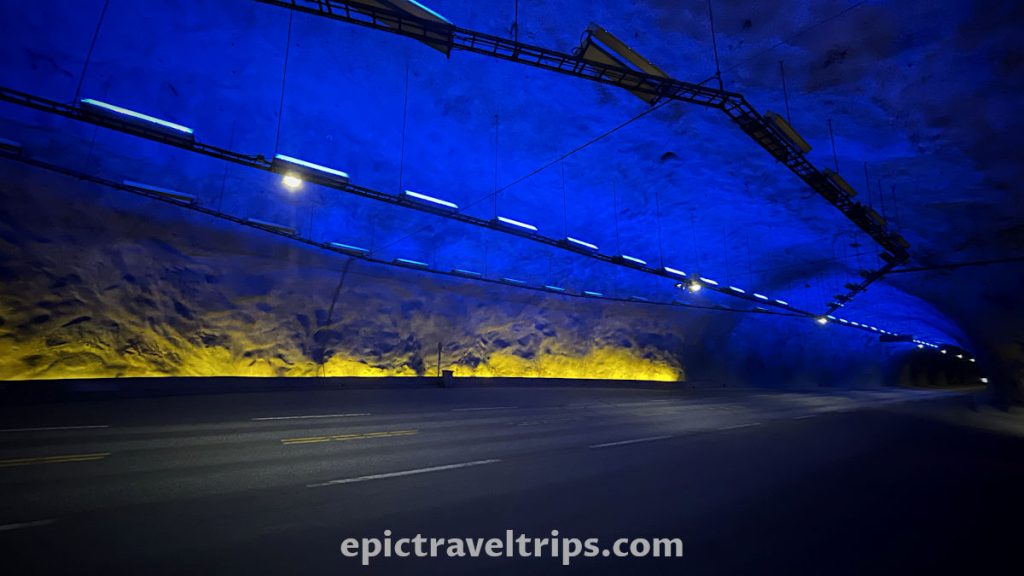
Lærdalsøyri
Lærdalsøyri is a small place tucked between steep knife-cut mountains. Lærdal River on one side of the valley slowly runs into the mirror-calm bay water. The bay is part of the much bigger fjord. Our hotel location is at the edges of the bay. It is popular among campers as overnighting place. The sunsets are fantastic here.
We used this location as our base to explore the Flåm area on our 3 Weeks Norway Epic Road Trip since it is cheaper.
If you click this link and make a purchase, we earn a commission at no additional cost to you.

Flam Railway (Flåmsbana)
Flåm Railway is a magnet for tourists in Flåm. It is attractive since it provides an engineering railway construction solution to overcome the high altitude of 866 meters (2841 ft.) in a short distance of only 20.2 km (12.6 mi). Such railways mean fantastic views, extraordinary nature, mountains, rivers, streams, waterfalls, tunnels, bridges, and long-lasting memories. In addition, you can combine a railway tour with zip line adventure, biking, and hiking at your own pace and discover this fantastic natural scenery yourself.
Just look at this beautiful photo by © Sverre Hjørnevik and you will be more than hooked to come and visit this extraordinary place.

Stegastein Viewpoint
Stegastein Viewpoint provides a panoramic view over the Aurlandsfjord, Aurlandsvangen village, and Aurland River (Aurlandselvi). The built platform is an engineering marvel in itself.
The platform is at a height of 650m (2 130 ft) above sea level. Such extreme height adds to the atmosphere of anticipation to look over the glassy wall and enjoy the panorama to the full extent.
As you can see in this beautiful photo from the © Sverre Hjørnevik, the platform, and the view are magnificent.
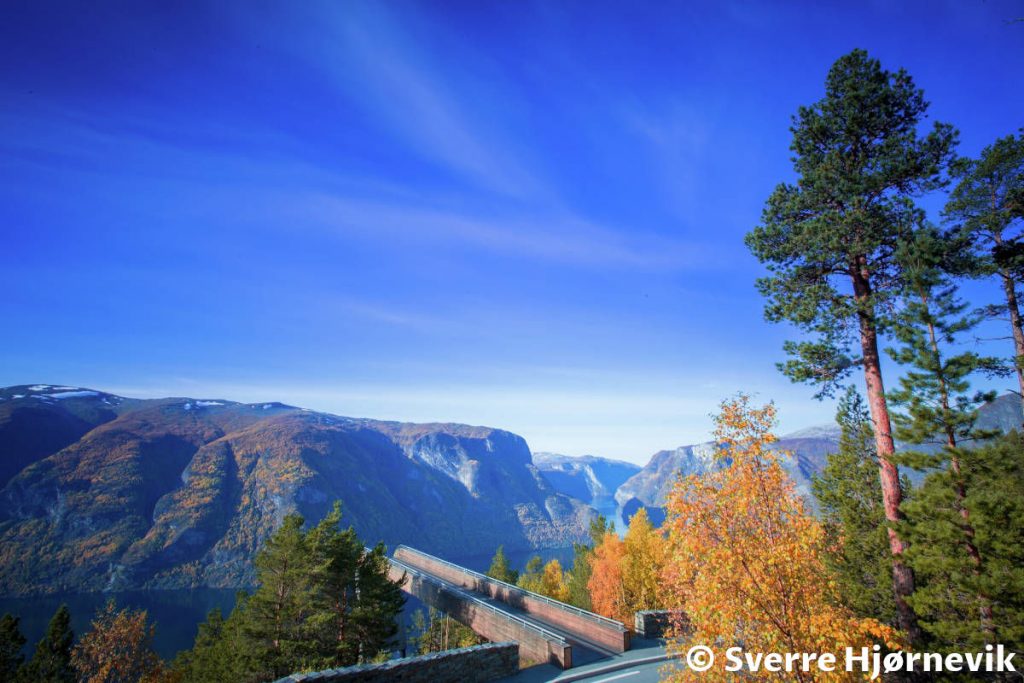
Aurlandsfjellet Scenic Route (The snow road)
Aurlandsfjellet Scenic Route (the snow road) season is only in the summer months.
The road is 47 km (29 miles) long. At some points, it goes just over 1 300 m (4 265 feet) above sea level. It is probably one of the best locations to get the sense of winter during the summer.
Instead of driving through Lærdal Tunnel to reach Flåm, in our opinion, the snow road is a much-exiting alternative. You can pass by Lærdalsøyri, drive over the mountains (the snow road), visit Stegastein Viewpoint, and finally reach Flåm as the end destination.
Look at the photo below from Fjord Norge / Visit Norway. It was the image we were imagining before driving the road, but…

When the season is open, usually the snow is very high, so car drives between the walls of snow on the roadsides.
We were not that lucky, and most of the snow melted in the mid of July. Only the short sections were still with pockets of snow. We need to come back earlier in the season.
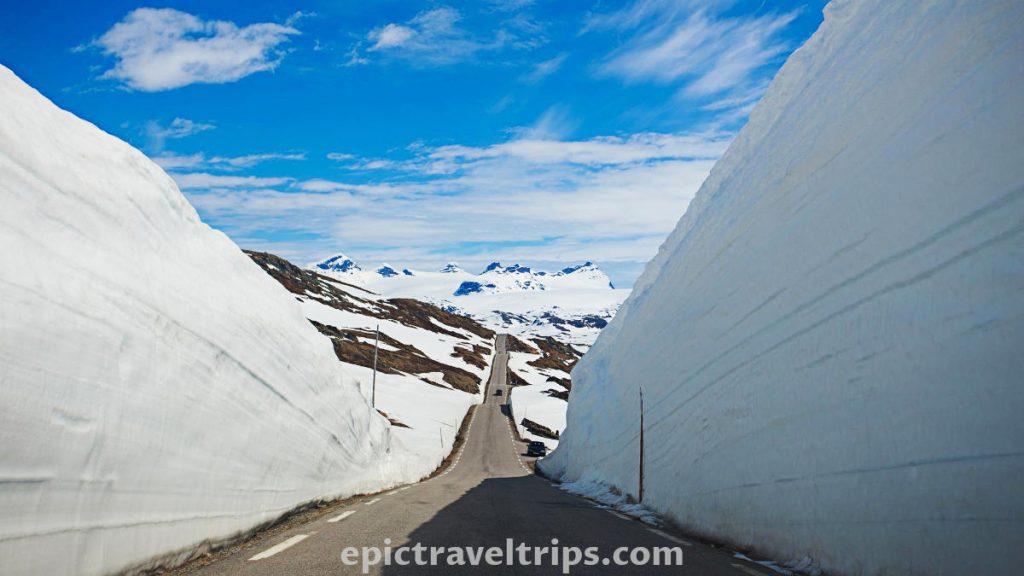
Aurlandsfjord
Aurlandsfjord is just an arm of a much larger labyrinth that makes up the largest fjord in Norway, the mighty Sognefjord. The fjord is 29km (18 miles) long. It is deep and narrow. However, Sognefjord is 206 km (128 mi) at the furthest arm, Lustra Fjord.
Flåm is at the end of Aurlandsfjord. Just look at the breathtaking view from Stegastein Viewpoint over the Aurlandsfjord.

Fjord Cruise Nærøyfjord
Slowly glide the waters of beautiful Aurlands & Nærøy Fjords in hybrid or electrical cruise ships from Flåm to Gudvangen and take the bus ride on your way back to Flåm and round up the trip. The ships have large windows and walkways in the shape of the final parts of the winding trails of the Flåm railway, so you can for sure find a spot to enjoy the view.
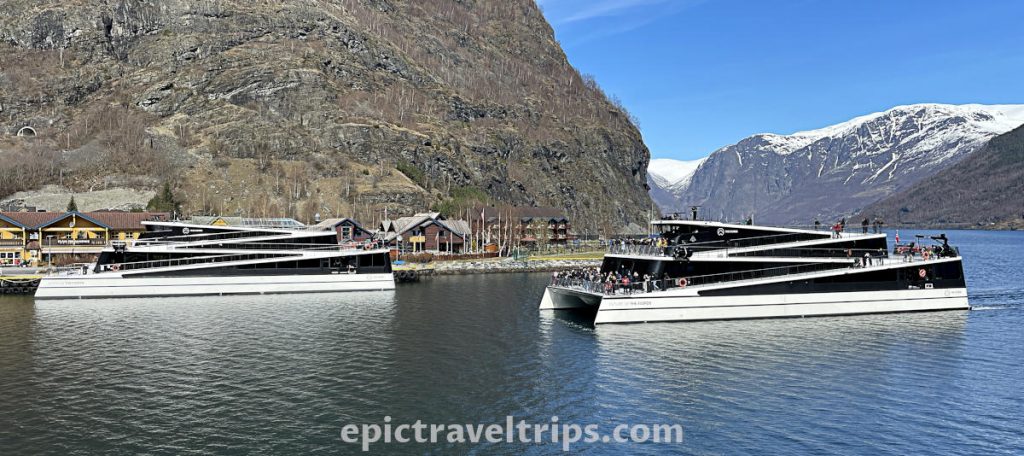
Just look at the photo of the beautiful Nærøy Fjord that ends at Gudvangen village.
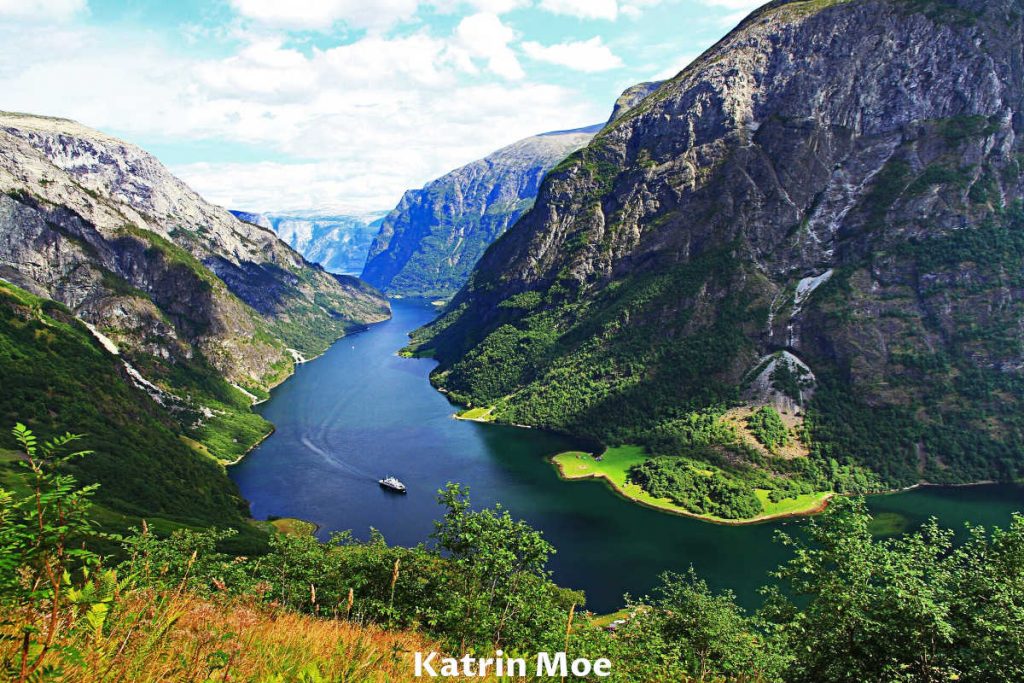
Aurlandsfjord Fjordsafari
Aurlandsfjord Fjordsafari is more suitable for the type of tourist looking for adrenalin and an adventurous experience rather than a relaxing cruise experience. Fjordsafari is one hour and thirty minutes water glide and wave ride on the RIP boats.
Thanks to the photo from © Fred Jonny Hammerø / Møre og Romsdal fylke, we can see how big a thrill the ride is for the passengers.
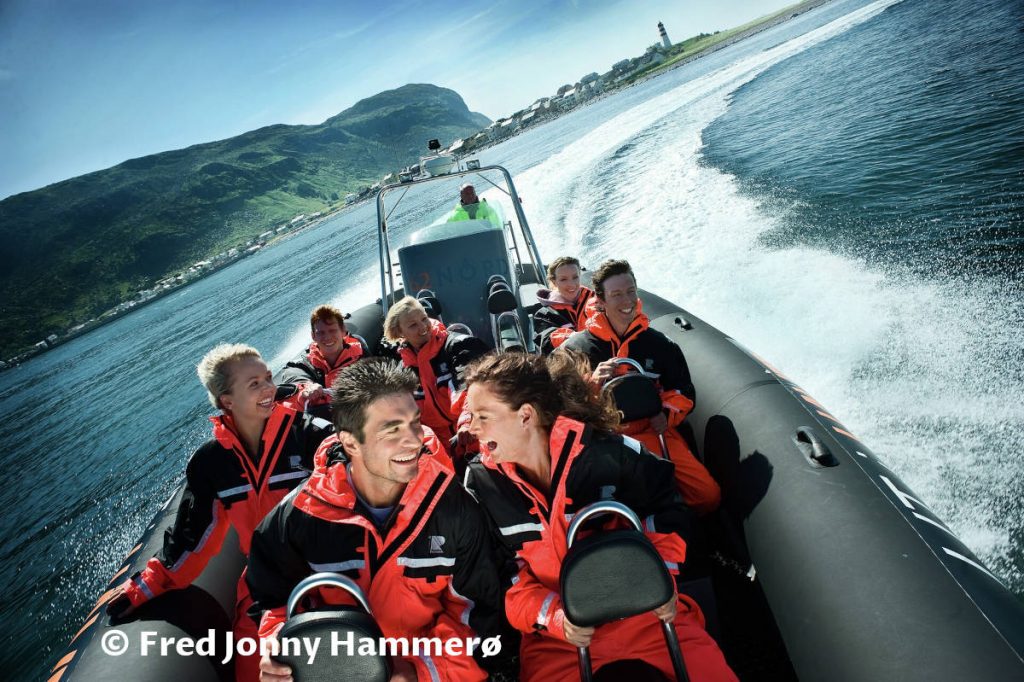
Borgund Stave Church – Our Impressions
A visit to Borgund is not just a tourist curiosity. It is primarily an introduction to Norwegian culture, history, and religion. Finally, we learned the similarities and differences in the construction of stave churches and Viking ships.
In combination with the Vindhellavegen hike, this was a total hit.
We will be glad to return and explore the Lærdalselvi mountain river valley further.

We wish you an epic trip!


